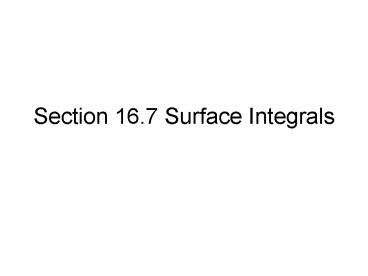Section 16.7 Surface Integrals - PowerPoint PPT Presentation
1 / 14
Title:
Section 16.7 Surface Integrals
Description:
Let's suppose the surface S is described by z=g(x,y) ... Normal vector to a surface ... of the normal vector and the surface area, this can be simplified... – PowerPoint PPT presentation
Number of Views:44
Avg rating:3.0/5.0
Title: Section 16.7 Surface Integrals
1
Section 16.7 Surface Integrals
2
Surface Integrals
We now consider integrating functions over a
surface S that lies above some plane region D.
3
Surface Integrals
Lets suppose the surface S is described by
zg(x,y) and we are considering a function
f(x,y,z) defined on S
The surface integral is given by
Where dS is the change in the surface AREA!
4
More useful
i.e. we convert a surface integral into a
standard double integral that we can compute!
5
Example
- Evaluate
Where
And S is the portion of the plane 2xy2z6 in
the first octant.
6
Surface Integrals
- We still need to discuss surface integrals of
vector fieldsbut we need a few new notions about
surfaces first. - Recall the vector form of a line integral (which
used the tangent vector to the curve) - For surface integrals we will make use of the
normal vector to the surface!
7
Normal vector to a surface
- If a surface S is given by zg(x,y), what is the
normal vector to the surface at a point
(x,y,g(x,y)) on the surface?
8
Definition Oriented Surface
- Suppose our surface has a tangent plane defined
at every point (x,y,z) on the surface - Then at each tangent plane there are TWO unit
normal vectors with n1 -n2 - If it is possible to choose a unit normal vector
n at every point (x,y,z) so that n varies
continuously over S, we say S is an oriented
surface
9
Example
Remark An oriented surface has two distinct
sides
Positive orientation
Negative orientation
10
Surface Integrals of Vector Fields
- If F is a continuous vector field defined on an
oriented surface S with unit normal vector n,
then the surface integral of F over S is
This is often called the flux of F across S
11
Using our knowledge of the normal vector and the
surface area, this can be simplified
12
i.e. a more simplified look at this
13
An application
- If is the density of a fluid
that is moving through a surface S with velocity
given by a vector field, F(x,y,z), then
Represents the mass of the fluid flowing across
the surface S per unit of time.
14
Example
- Let S be the portion of the paraboloid
- Lying above the xy-plane oriented by an upward
normal vector. A fluid with a constant density is
flowing through the surface S according to the
velocity field F(x,y,z) ltx,y,zgt. Find the rate
of mass flow through S.































